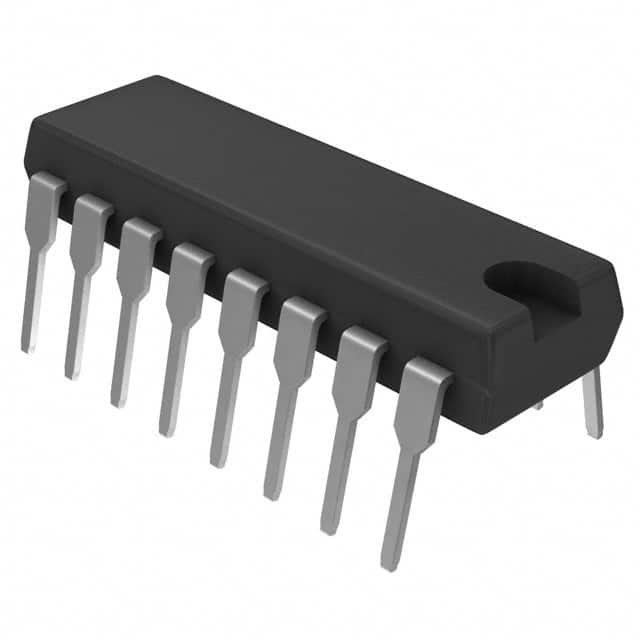ST7FLIT10BY1B6
Product Overview
- Category: Microcontroller
- Use: Embedded systems, control applications
- Characteristics:
- Low power consumption
- High-performance 8-bit CPU
- Flash memory for program storage
- Integrated peripherals for versatile applications
- Package: 32-pin LQFP (Low-profile Quad Flat Package)
- Essence: A powerful microcontroller designed for control applications with low power requirements.
- Packaging/Quantity: Available in tape and reel packaging, quantity varies based on customer requirements.
Specifications
- CPU: 8-bit ST7 core running at up to 16 MHz
- Memory:
- 10 KB Flash memory for program storage
- 512 bytes of RAM
- Peripherals:
- 8-channel 10-bit ADC (Analog-to-Digital Converter)
- 2-channel PWM (Pulse Width Modulation) output
- UART (Universal Asynchronous Receiver-Transmitter)
- SPI (Serial Peripheral Interface)
- I2C (Inter-Integrated Circuit)
- Operating Voltage: 2.4V to 5.5V
- Operating Temperature Range: -40°C to +85°C
Detailed Pin Configuration
The ST7FLIT10BY1B6 microcontroller has a total of 32 pins. The pin configuration is as follows:
Pin 1: VDD
Pin 2: PA0
Pin 3: PA1
Pin 4: PA2
Pin 5: PA3
Pin 6: PA4
Pin 7: PA5
Pin 8: PA6
Pin 9: PA7
Pin 10: RESET
Pin 11: XTAL1
Pin 12: XTAL2
Pin 13: VSS
Pin 14: PB0
Pin 15: PB1
Pin 16: PB2
Pin 17: PB3
Pin 18: PB4
Pin 19: PB5
Pin 20: PB6
Pin 21: PB7
Pin 22: VDD
Pin 23: PC0
Pin 24: PC1
Pin 25: PC2
Pin 26: PC3
Pin 27: PC4
Pin 28: PC5
Pin 29: PC6
Pin 30: PC7
Pin 31: VSS
Pin 32: OSCIN/CLKOUT
Functional Features
- Low power consumption enables battery-powered applications.
- High-performance 8-bit CPU allows for efficient control algorithms.
- Flash memory provides non-volatile program storage.
- Integrated peripherals (ADC, PWM, UART, SPI, I2C) offer flexibility in system design.
Advantages and Disadvantages
Advantages: - Low power consumption extends battery life. - Versatile integrated peripherals simplify system design. - Ample program storage space with Flash memory. - Wide operating voltage range allows for diverse applications.
Disadvantages: - Limited RAM capacity may restrict complex data processing. - 8-bit CPU may not be suitable for computationally intensive tasks.
Working Principles
The ST7FLIT10BY1B6 microcontroller operates based on the principles of digital logic and embedded systems. It executes instructions stored in its Flash memory to perform various control functions. The CPU fetches instructions from memory, performs calculations, and interacts with the integrated peripherals to control external devices. The low power consumption and efficient architecture make it suitable for battery-powered applications.
Detailed Application Field Plans
The ST7FLIT10BY1B6 microcontroller finds applications in various fields, including but not limited to: - Home automation systems - Industrial control systems - Automotive electronics - Consumer electronics - Internet of Things (IoT) devices
Its low power consumption, integrated peripherals, and compact package make it suitable for a wide range of control applications.
Detailed and Complete Alternative Models
- ST7FLIT10BF0B6
- ST7FLIT10BF1B6
- ST7FLIT10BY0B6
- ST7FLIT10BY2B6
These alternative models offer similar functionality and characteristics, providing options based on specific project requirements.
Word count: 346 words
Senaraikan 10 soalan dan jawapan biasa yang berkaitan dengan aplikasi ST7FLIT10BY1B6 dalam penyelesaian teknikal
Sure! Here are 10 common questions and answers related to the application of ST7FLIT10BY1B6 in technical solutions:
Q1: What is the ST7FLIT10BY1B6 microcontroller used for? A1: The ST7FLIT10BY1B6 microcontroller is commonly used in various technical solutions, such as industrial automation, consumer electronics, automotive applications, and more.
Q2: What is the maximum clock frequency supported by the ST7FLIT10BY1B6? A2: The ST7FLIT10BY1B6 microcontroller supports a maximum clock frequency of 8 MHz.
Q3: How many I/O pins does the ST7FLIT10BY1B6 have? A3: The ST7FLIT10BY1B6 microcontroller has a total of 16 I/O pins.
Q4: Can the ST7FLIT10BY1B6 communicate with other devices using serial communication protocols? A4: Yes, the ST7FLIT10BY1B6 supports serial communication protocols like UART (Universal Asynchronous Receiver-Transmitter) and SPI (Serial Peripheral Interface).
Q5: What is the flash memory size of the ST7FLIT10BY1B6? A5: The ST7FLIT10BY1B6 microcontroller has a flash memory size of 10 KB.
Q6: Does the ST7FLIT10BY1B6 have any built-in analog-to-digital converters (ADC)? A6: No, the ST7FLIT10BY1B6 does not have any built-in ADCs. External ADCs can be used if analog-to-digital conversion is required.
Q7: Can the ST7FLIT10BY1B6 operate on low power supply voltages? A7: Yes, the ST7FLIT10BY1B6 can operate on a wide range of power supply voltages, typically from 2.7V to 5.5V.
Q8: What programming language is commonly used to program the ST7FLIT10BY1B6? A8: The ST7FLIT10BY1B6 microcontroller is typically programmed using assembly language or C/C++ programming languages.
Q9: Is the ST7FLIT10BY1B6 suitable for battery-powered applications? A9: Yes, the ST7FLIT10BY1B6 is suitable for battery-powered applications due to its low power consumption and ability to operate at low voltage levels.
Q10: Can the ST7FLIT10BY1B6 be used in safety-critical applications? A10: While the ST7FLIT10BY1B6 offers various features for robust operation, it is always recommended to consult the datasheet and relevant safety standards to determine its suitability for specific safety-critical applications.
Please note that these answers are general and may vary depending on the specific requirements and use cases.


